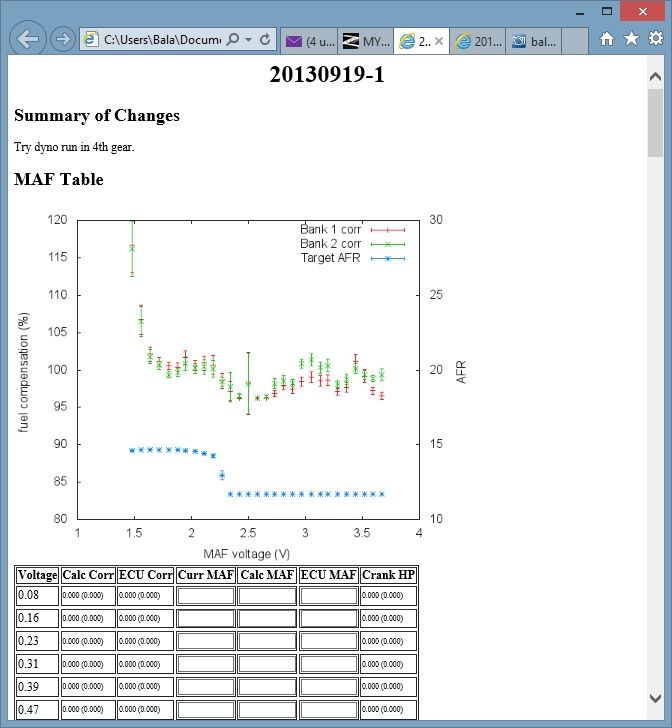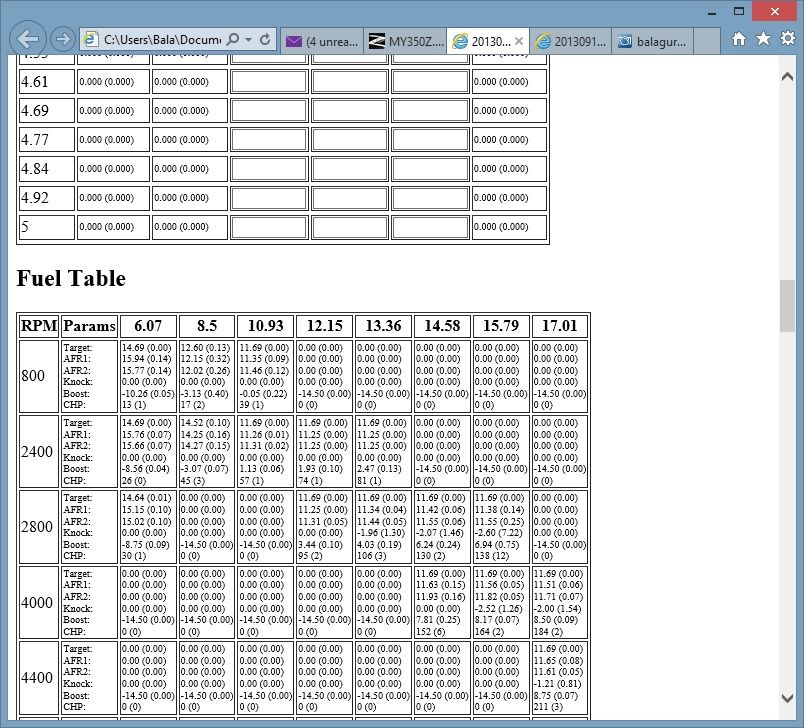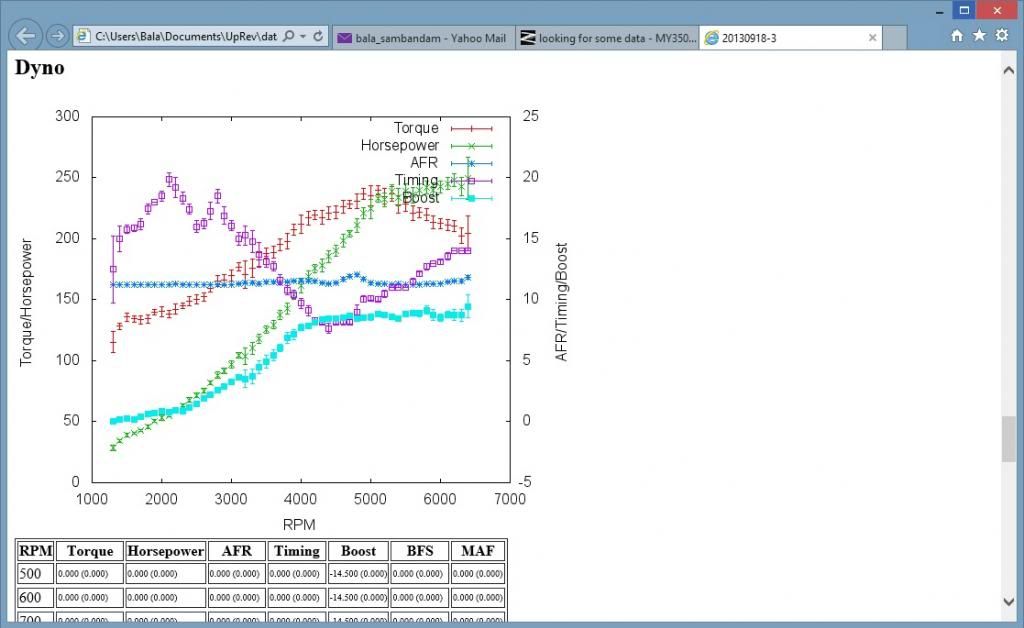looking for some data
#1
So I have my data analysis code pretty much working. It would be very helpful to me to have some data to compare my data to while I do this--hence the reason for this post.
What I need is UpRev datalog files. In return I'll run your data through my scripts and send you the results. Results come back as a compressed folder. There is an HTML web page that you open in your browser which gives you the report. Here's what you get.
1. All numbers are reported as a 95% confidence intervals of the format x (d) which means that the true value being estimated resides within the interval x - d to x + d with a confidence of 95%. You can use this to compare data from multiple runs. If 2 intervals do not overlap then there is a statistical significant difference in whatever you are measuring assuming alpha=0.05. For example, you see crank HP calculated at 300 (10) for a particular timing cell. You change timing and now see crank HP listed as 325 (10) for the same cell. Since the first interval 290-310 does not overlap with the second interval 315-335 you can assume that whatever change you made had a statistically significant benefit given your data.
2. The MAF table analysis gives you a graph for rough qualitative information on how much correction you need in your MAF table to make your actual AFR equal your target AFR. The table that goes along with the graph has javascript embedded in it so you can enter your current MAF table values and it will compute the new MAF table values needed to hit target AFR. 2 calculated numbers are reported. One is based on the ECU correction which I use for the closed loop MAF voltages. The other is based on measured AFR vs target AFR which I use for the open loop MAF voltages. You can usually set the entire MAF table using just 1 run of data. If your actual AFR is less than 11.25 which is the limit of the OEM wideband sensors then you will not get a valid new MAF value that will get you right at target AFR but it will get you closer. You'll need more runs or you will need to overshoot and lean your AFR into the readable range.
3. The fuel table will recreate the UpRev fuel table using the data from the log files. It will also map things like knock strength, boost (if you have the Innovate MAP sensor set up) and crank HP on the fuel map. This can be used to choose new target AFR as indicated by some of the other data that gets mapped on the table. I use the stock bins of RPM and BFS. Let me know if you need different bins.
4. The timing table works like the fuel able. It recreates the timing table using the data from the log files except it uses actual timing advance BTDC instead of the burn time found in the UpRev table. It also maps AFR, knock strength, boost and crank HP onto the table.
5. The dyno graph and table are calculated from the data log. To get usable information from this you need to limit your WOT driving to the same gear but it can be done in spurts. I do about 0.5 second of smoothing which means to compute a single HP/TQ I need 0.5s of data. So you don't necessarily need to do a full run from 1k to 7k rpm. If my code is working properly you could do 1k to 3k and then when safe 3k to 5k and then 5k to 7k even later. Or you could do it completely out of order. I just need enough data to calculate the HP/TQ for all RPMs. Obviously, be safe when you get this data. If you go WOT in different gears then the confidence intervals will be much wider as the spread of data will be much wider. Gear ratio per say has no effect on converting wheel horsepower to crank horsepower because they are in fact equal but the transmission seems to convert a portion of engine work into heat differently at different gear ratios. So to get good data that you can use you need to use the same gear so that your confidence intervals are narrow. It can be any gear. It just needs to be consistent. Also avoid spinning your wheels as this will give you spikes in HP and avoid driving uphill or downhill at WOT as I have no way of accounting for this.
6. Catalytic converter activity information is also provided. I calculate a few things for each O2 sensor. The switching voltage is the voltage that the sensor seems to oscillate around when the target AFR is 14.7. The switching frequency is the frequency in Hz that the voltage oscillates around for that switching voltage. The stoich switching frequency is the frequency that the voltage crosses the 1.5V mark for WB sensors and 0.45V for NB sensors. I cannot find what the lower limit is in the FSM or the googleverse but you should probably have a precat/postcat stoich switching frequency ratio of at least 1.0 for the ECU not to complain about catalytic converter efficiency.
For the SAE correction to work I need the atmospheric conditions that were present when you made the log. I'll need barrometric pressure in inches, temperature in F and dew point in F. You can find this information by zip code at http://weather.com.
Here what I need: examples are from my setup
Summary of tune: ex Tuned MAF table from 2.5 to 3.67 volts.
Weight of car/driver/fuel in lbs: ex 3600
OEM rear tire size: ex 245/45R18
Current rear tire size: ex 275/40R17
Coef of drag: ex 0.29
Frontal area in sq ft: ex 25.2
Then record the following params using ROM editor. Cipher may work but I'll probably have to massage the data as my scripts expect ROM editor data.
1. AFR correction B1
2. AFR correction B2
3. AF WB B1 volts
4. AF WB B2 volts
5. AFR WB B1
6. AFR WB B2
7. Base Fuel Schedule (the first one listed in ROM editor. This shows the BFS as a number like 3.5 ms)
8. Coolant temp (C)
9. Engine speed (the second one listed in ROM editor)
10. Ignition timing advance
11. Intake air temp (C)
12. Knock strength
13. MAF volts (both banks if available)
14. NB O2 sensor B1 volts
15. NB O2 sensor B2 volts
16. Target AFR
17. Accelerator pedal sensor 1 volts
18. Vehicle speed (MPH)
19. Innovate Aux corresponding to your MAP sensor if installed
20. Intake cam timing B1
21. Intake cam timing B2
Feel free to record megs of data for narrower confidence intervals. I think the limit on my yahoo account for email attachments is 25meg. Usually 10 - 20 minutes of data is more than enough and corresponds to less than 5meg. Here are some screen captures of the report. My email is first_lastname@yahoo.com, obfuscated for the bots. Replace 'first' with my first name listed in my sig and 'lastname' with my lastname in my sig.





What I need is UpRev datalog files. In return I'll run your data through my scripts and send you the results. Results come back as a compressed folder. There is an HTML web page that you open in your browser which gives you the report. Here's what you get.
1. All numbers are reported as a 95% confidence intervals of the format x (d) which means that the true value being estimated resides within the interval x - d to x + d with a confidence of 95%. You can use this to compare data from multiple runs. If 2 intervals do not overlap then there is a statistical significant difference in whatever you are measuring assuming alpha=0.05. For example, you see crank HP calculated at 300 (10) for a particular timing cell. You change timing and now see crank HP listed as 325 (10) for the same cell. Since the first interval 290-310 does not overlap with the second interval 315-335 you can assume that whatever change you made had a statistically significant benefit given your data.
2. The MAF table analysis gives you a graph for rough qualitative information on how much correction you need in your MAF table to make your actual AFR equal your target AFR. The table that goes along with the graph has javascript embedded in it so you can enter your current MAF table values and it will compute the new MAF table values needed to hit target AFR. 2 calculated numbers are reported. One is based on the ECU correction which I use for the closed loop MAF voltages. The other is based on measured AFR vs target AFR which I use for the open loop MAF voltages. You can usually set the entire MAF table using just 1 run of data. If your actual AFR is less than 11.25 which is the limit of the OEM wideband sensors then you will not get a valid new MAF value that will get you right at target AFR but it will get you closer. You'll need more runs or you will need to overshoot and lean your AFR into the readable range.
3. The fuel table will recreate the UpRev fuel table using the data from the log files. It will also map things like knock strength, boost (if you have the Innovate MAP sensor set up) and crank HP on the fuel map. This can be used to choose new target AFR as indicated by some of the other data that gets mapped on the table. I use the stock bins of RPM and BFS. Let me know if you need different bins.
4. The timing table works like the fuel able. It recreates the timing table using the data from the log files except it uses actual timing advance BTDC instead of the burn time found in the UpRev table. It also maps AFR, knock strength, boost and crank HP onto the table.
5. The dyno graph and table are calculated from the data log. To get usable information from this you need to limit your WOT driving to the same gear but it can be done in spurts. I do about 0.5 second of smoothing which means to compute a single HP/TQ I need 0.5s of data. So you don't necessarily need to do a full run from 1k to 7k rpm. If my code is working properly you could do 1k to 3k and then when safe 3k to 5k and then 5k to 7k even later. Or you could do it completely out of order. I just need enough data to calculate the HP/TQ for all RPMs. Obviously, be safe when you get this data. If you go WOT in different gears then the confidence intervals will be much wider as the spread of data will be much wider. Gear ratio per say has no effect on converting wheel horsepower to crank horsepower because they are in fact equal but the transmission seems to convert a portion of engine work into heat differently at different gear ratios. So to get good data that you can use you need to use the same gear so that your confidence intervals are narrow. It can be any gear. It just needs to be consistent. Also avoid spinning your wheels as this will give you spikes in HP and avoid driving uphill or downhill at WOT as I have no way of accounting for this.
6. Catalytic converter activity information is also provided. I calculate a few things for each O2 sensor. The switching voltage is the voltage that the sensor seems to oscillate around when the target AFR is 14.7. The switching frequency is the frequency in Hz that the voltage oscillates around for that switching voltage. The stoich switching frequency is the frequency that the voltage crosses the 1.5V mark for WB sensors and 0.45V for NB sensors. I cannot find what the lower limit is in the FSM or the googleverse but you should probably have a precat/postcat stoich switching frequency ratio of at least 1.0 for the ECU not to complain about catalytic converter efficiency.
For the SAE correction to work I need the atmospheric conditions that were present when you made the log. I'll need barrometric pressure in inches, temperature in F and dew point in F. You can find this information by zip code at http://weather.com.
Here what I need: examples are from my setup
Summary of tune: ex Tuned MAF table from 2.5 to 3.67 volts.
Weight of car/driver/fuel in lbs: ex 3600
OEM rear tire size: ex 245/45R18
Current rear tire size: ex 275/40R17
Coef of drag: ex 0.29
Frontal area in sq ft: ex 25.2
Then record the following params using ROM editor. Cipher may work but I'll probably have to massage the data as my scripts expect ROM editor data.
1. AFR correction B1
2. AFR correction B2
3. AF WB B1 volts
4. AF WB B2 volts
5. AFR WB B1
6. AFR WB B2
7. Base Fuel Schedule (the first one listed in ROM editor. This shows the BFS as a number like 3.5 ms)
8. Coolant temp (C)
9. Engine speed (the second one listed in ROM editor)
10. Ignition timing advance
11. Intake air temp (C)
12. Knock strength
13. MAF volts (both banks if available)
14. NB O2 sensor B1 volts
15. NB O2 sensor B2 volts
16. Target AFR
17. Accelerator pedal sensor 1 volts
18. Vehicle speed (MPH)
19. Innovate Aux corresponding to your MAP sensor if installed
20. Intake cam timing B1
21. Intake cam timing B2
Feel free to record megs of data for narrower confidence intervals. I think the limit on my yahoo account for email attachments is 25meg. Usually 10 - 20 minutes of data is more than enough and corresponds to less than 5meg. Here are some screen captures of the report. My email is first_lastname@yahoo.com, obfuscated for the bots. Replace 'first' with my first name listed in my sig and 'lastname' with my lastname in my sig.





Last edited by balaguru; 10-29-2013 at 07:29 PM.
#3
Thread
Thread Starter
Forum
Replies
Last Post
Workshop12
Exterior & Interior
256
03-23-2020 01:45 PM
BlinkerFluid
Engine
0
09-08-2015 10:06 AM




